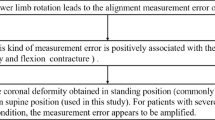Abstract
Objectives
A profound knowledge of physiologic lower limb alignment is essential to understand deformities and to plan surgical correction. The gold standard in radiographic assessment is the long standing radiograph with a forward directed patella. The advantage of computed tomography (CT) is that its cutting-edge image technique can visualize the femur condyles. Study purpose was to determine if the CT-scout view has the potential to replace the standing radiograph.
Materials and methods
We compared the geometric data obtained from long standing radiograph and CT-scout views both with patella forward position. Furthermore, we developed a method of positioning the lower extremity stable on the CT table, where the femoral condyles became the new orientation criterion. Finally, we evaluated differences in the data ascertainment between the long standing radiograph with patella facing forward and the CT-scout view with the posterior edge of femoral condyles orientated parallel to the radiographic cassette.
Results
The geometric data of long standing radiograph and CT-scout views are comparable if the leg is in the same rotational position. We developed a CT positioning jig to adjust the femur condyles parallel to the radiographic cassette. In 80 % of the cases, the deviation was 5° or less. These scout views showed statistically significant differences when compared with data from standing radiograph with a forward centered patella.
Conclusion
No evidence was found clearly excluding the possibility of an exclusive use of the CT-scout view for the analysis of the leg geometry. However, advantages of the long standing radiograph became obvious.







Similar content being viewed by others
References
Cooke TD (2002) Definition of axial alignment of the lower extremity. J Bone Joint Surg [Am] 84-A:146–147
Gladbach B, Pfeil J, Heijens E (1999) Correction of leg deformities. Definition, estimation and realignment of axis deviation and misalignment. Orthopade 28:1023–1033
Paley D, Tetsworth K (1992) Mechanical axis deviation of the lower limbs. Preoperative planning of uniapical angular deformities of the tibia or femur. Clin Orthop Relat Res 280:48–64
Chao EY, Neluheni EV, Hsu RW, Paley D (1994) Biomechanics of malalignment. Orthop Clin N Am 25:379–386
Sabharwal S, Zhao C (2008) Assessment of lower limb alignment: supine fluoroscopy compared with a standing full-length radiograph. J Bone Joint Surg Am 90:43–51
Siu D, Cooke TD, Broekhoven LD, Lam M, Fischer B, Saunders G, Challis TW (1991) A standardized technique for lower limb radiography. Practice, application, and error analysis. Invest Radiol 26:71–77
Paley D (2002) Principles of deformity correction. Springer, Berlin, Heidelberg, New York
Grunert S, Brückl R, Rosemeyer B (1986) Rippstein and Müller roentgenologic determination of the actual femoral neck-shaft and antetorsion angle. 1: Correction of the conversion table and study of the effects of positioning errors. Radiologe 26:293–304
Guichet JM, Javed A, Russel J, Saleh M (2003) Effect of the foot on the mechanical alignment of the lower limbs. Clin Orthop Relat Res 415:193–201
Hunt MA, Fowler PJ, Birmingham TB, Jenkyn TR, Giffin JR (2006) Foot rotational effects on radiographic measures of lower limb alignment. Can J Surg 49:401–406
Brouwer RW, Jakma TS, Brouwer KH, Verhaar JA (2007) Pitfalls in determining knee alignment: a radiographic cadaver study. J Knee Surg 20:210–215
Augele I (1996) Prospektiver Vergleich konventioneller langer Beinaufnahmen mit Topogrammen der Computertomographie unter Simulation der Schwerkraft. Tectum-Verlag (German Thesis)
Hinterwimmer S, Graichen H, Vogl TJ, Aboolmali N (2008) An MRI-based technique for assessment of lower extremity deformities—reproducibility, accuracy, and clinical application. Eur Radiol 18:1497–1505
Hsu RW, Himeno S, Conventry MB, Chao EY (1990) Normal axial alignment of the lower extremity and load-bearing distribution at the knee. Clin Orthop Relat Res 255:215–227
von Lanz T, Lang J, Wachsmuth W (1972) Praktische Anatomie, Erster Band, Vierter Teil: Bein und Statik. Springer, Berlin, Heidelberg, New York
Bhave A, Paley D, Herzenberg JE (1999) Improvement in gait parameters after lengthening for the treatment of limb-length discrepancy. J Bone Joint Surg [Am] 81:529–534
Kendoff D, Board TN, Citak M, Gardner MJ, Hankemeier S, Ostermeier S, Krettek C, Hüfner T (2008) Navigated lower limb axis measurements: influence of mechanical weight-bearing simulation. J Orthop Res 26:553–561
Endler F, Fochem K, Weil UH (1984) Orthopädische Röntgendiagnostik—Längenunterschiede und Achsfehlstellungen des Beines. Georg Thieme Verlag, Stuttgart, New York
Keppler P, Strecker W, Kinzl L (1998) Analysis of leg geometry—standard techniques and normal values. Chirurgie 69:1141–1152 (German)
Wright JG, Treble N, Feinstein AR (1991) Measurement of lower limb alignment using long radiographs. J Bone Joint Surg Br 73:721–723
Sharma L, Song J, Felson DT, Cahue S, Shamiyeh E, Dunlop DD (2001) The role of knee alignment in disease progression and functional decline in knee osteoarthritis. JAMA 286:188–195
Moreland JR, Bassett LW, Hanker GJ (1987) Radiographic analysis of the axial alignment of the lower extremity. J Bone Joint Surg Am 69:745–749
Conflict of interest
None of the authors received any financial or other sources of support.
Author information
Authors and Affiliations
Corresponding author
Rights and permissions
About this article
Cite this article
Burghardt, R.D., Hinterwimmer, S., Bürklein, D. et al. Lower limb alignment in the frontal plane: analysis from long standing radiographs and computer tomography scout views: an experimental study. Arch Orthop Trauma Surg 133, 29–36 (2013). https://doi.org/10.1007/s00402-012-1635-z
Received:
Published:
Issue Date:
DOI: https://doi.org/10.1007/s00402-012-1635-z




